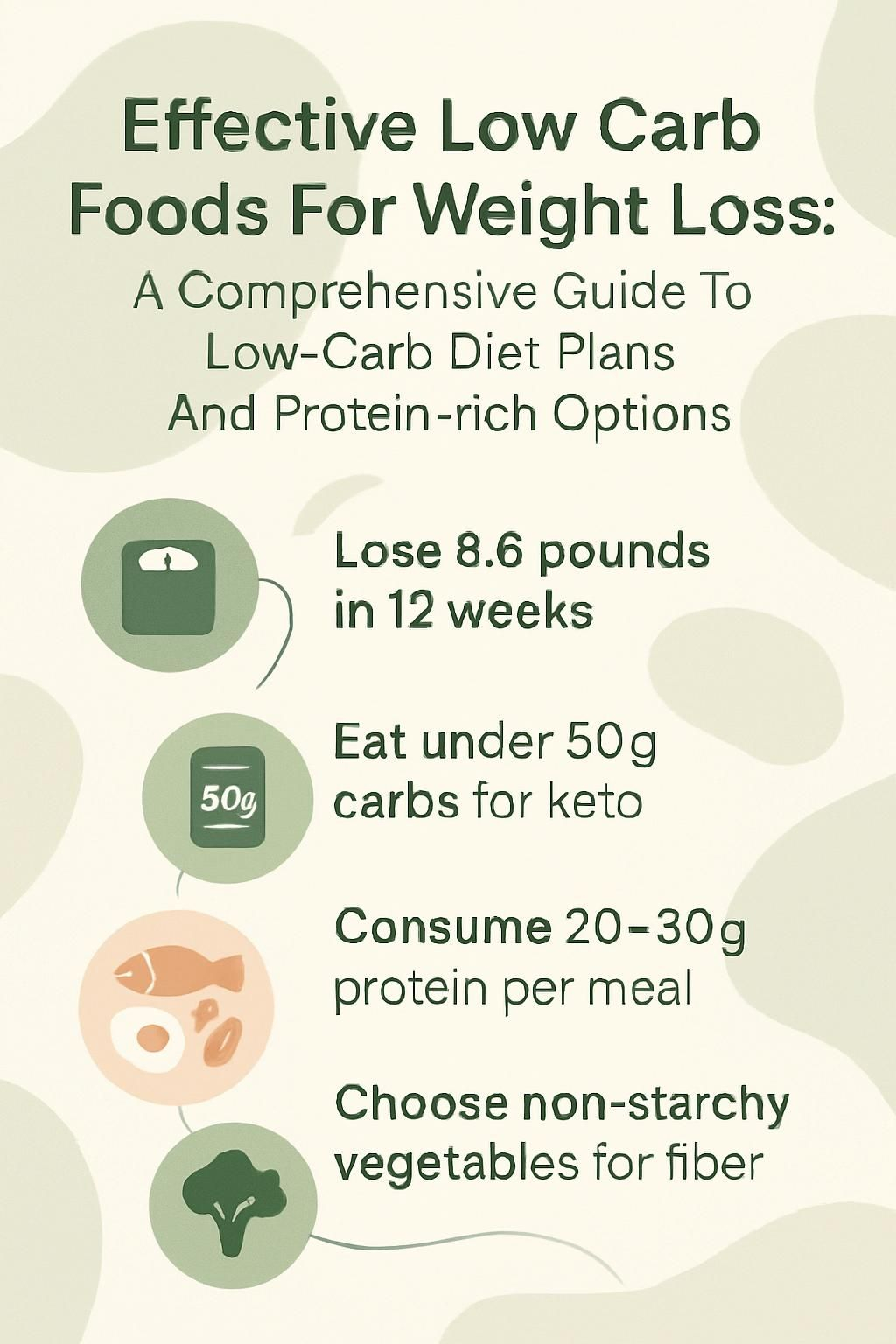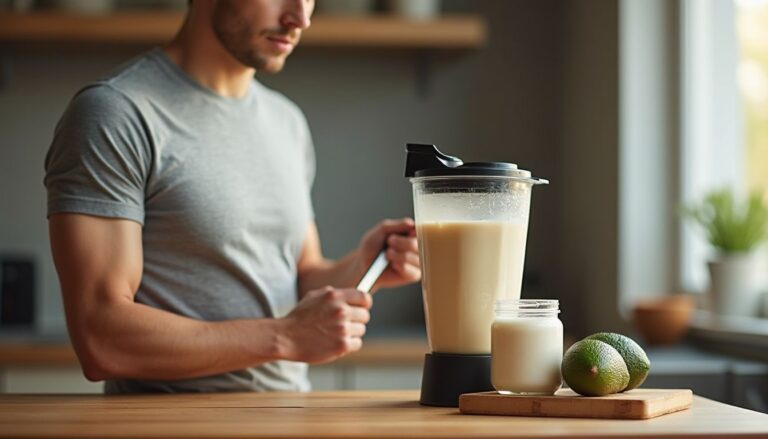Effective Low Carb Foods For Weight Loss: A Comprehensive Guide To Low-Carb Diet Plans And Protein-rich Options
Our Nutrition Assistant AI Suite will transform your body. You will lose fat, get toned, and build muscle. Gain confidence and optimal health.
Stalled progress feels discouraging, especially with mixed advice about carbs. A well planned low-carb diet can help you lose weight and steady your blood sugar. This guide shows how it works, offers simple meal ideas, and highlights protein choices that support results.
You will learn the basics, see practical food lists, and pick strategies that fit your routine. Small changes add up. Start with one meal, then build your plan step by step.
Key Takeaways
- Several studies report greater weight loss with low-carb plans compared with low-fat plans. A 2022 review found an average of 8.6 pounds lost in 12 weeks on low carb versus 4.2 pounds on low fat.
- Keeping carbs under 130 grams per day, and 20 to 50 grams for keto, can stabilize blood sugar and improve insulin control, especially for people with type 2 diabetes.
- Eating 20 to 30 grams of protein per meal from eggs, lean meats, fish, dairy, nuts, and seeds helps preserve muscle and can raise calorie burn during digestion by up to 30 percent.
- Choosing non-starchy vegetables like spinach and broccoli adds fiber and volume without many carbs; swapping in these foods may reduce cravings and overall calories.
- Research in Obesity (2013) suggests high-protein, low-carb plans can improve fat loss while helping keep energy steady across the day.

Understanding Low-Carb Diets

A low-carb diet reduces your carbohydrate intake and focuses on foods low in carbs. This eating pattern can support weight loss, better blood sugar, and more stable energy.
What Is a Low-Carb Diet?
On a low-carb diet, you limit foods high in sugar and starch. That includes bread, pasta, rice, and sweets. You build meals with more protein and healthy fats plus non-starchy vegetables.
Common choices include eggs, chicken, fish, cucumbers, spinach, nuts, seeds, cheese, plain yogurt, and oils like olive or avocado. Most plans set carbs below 130 grams per day. Ketogenic diets often drop to 20 to 50 grams daily.
Lower carbohydrate intake may reduce blood sugar swings and curb appetite, which helps with weight loss. People with type 2 diabetes or prediabetes often use this approach to improve insulin control.
How Do Low-Carb Diets Help With Weight Loss?
Cutting high-carb foods such as bread, pasta, and sweets pushes your body to burn stored fat for energy instead of relying on glucose. Fewer carbs can stabilize blood sugar and reduce insulin spikes, which can lower fat storage.
A 2022 analysis found that people on low-carb diets for 12 weeks lost an average of 8.6 pounds, versus 4.2 pounds on low fat. Higher protein and healthy fats also increase fullness. A breakfast of eggs or Greek yogurt usually satisfies longer than cereal or white toast.
Many people report fewer cravings within a week. You are also more likely to maintain lean muscle because of the higher protein intake, which supports metabolism during weight loss. Filling your plate with non-starchy vegetables like spinach and broccoli adds fiber with minimal carbs.
“After I started my own low-carb diet, I felt more energetic and snacked way less during busy workdays.”
Benefits of Low-Carb Diets for Weight Loss
Low-carb diets can help you lose fat, steady blood sugar, and tame cravings. These benefits make it easier to stick with your plan.
How Do Low-Carb Diets Speed Up Fat Loss?
Eating fewer carbs shifts your body to use fat for fuel. In ketosis, the liver makes ketones from fat, which power your brain and muscles. Early weight loss may be faster than on higher-carb approaches.
A 2014 review found people lost 2 to 3 times more weight in the first six months on low carb compared with low fat. Lower insulin levels also reduce fat storage, which can shrink waist size, a known risk marker for heart disease and type 2 diabetes.
Many people see improved triglycerides and HDL cholesterol with a low-carb approach. These changes support cardiovascular health.
Can Low-Carb Diets Stabilize Blood Sugar Levels?
Limiting refined grains and added sugars reduces blood sugar spikes and crashes. This steadier pattern improves insulin sensitivity, which helps the body use glucose more effectively.
Some studies report up to a 1 percent drop in HbA1c, a long-term blood sugar marker, after several months on low carb. Stable blood sugar often means fewer energy dips and fewer snack urges between meals.
One reader shared:
After switching to a high protein, low carb diet, my afternoon tiredness faded away and my test results showed better numbers.
These benefits grow when you pair your diet with movement, sleep, and good hydration.
Do Low-Carb Diets Boost Metabolism and Energy?
Low-carb diets often include more protein, which requires more energy to digest. Some research shows resting energy burn can rise by 100 to 150 calories per day on low carb plans.
Steadier blood sugar leads to fewer energy crashes. Many people feel more alert after swapping toast or cereal for eggs with greens and olive oil. Consistent energy helps with focus at work or school.
How Do Low-Carb Diets Reduce Hunger and Cravings?
Protein and healthy fats increase satiety, which makes it easier to eat fewer calories. Foods like eggs, chicken, and avocado keep you full longer than high-carb options.
In a 2014 study, people on low carb reported less hunger. High fiber vegetables such as leafy greens, broccoli, and cauliflower also curb cravings by adding volume with minimal carbs.
Key Components of a Low-Carb Diet Plan
Success comes from the right balance of protein, healthy fats, and non-starchy vegetables. These parts work together to control hunger and protect muscle.
Why Is Protein Important for Low-Carb Success?
Protein protects muscle while you reduce carbs and calories. More protein can raise calorie burn during digestion, which supports fat loss. It also helps control cravings and keeps you satisfied between meals.
Good options include lean meats, eggs, Greek yogurt, and legumes. Aim for 20 to 30 grams of protein per meal. This range is often suggested for people working on weight loss or managing type 2 diabetes.
Pair protein with fiber from vegetables to improve fullness and make your plan easier to follow.
How Do Healthy Fats Support Energy on Low-Carb Diets?
When carbs are low, healthy fats become a main fuel. This shift, called ketosis, uses fat for energy. Choose avocados, olive oil, nuts, seeds, salmon, and cheese to help you stay satisfied.
These foods do not spike insulin, which supports stable blood sugar. Many people enjoy the flavor boost from using olive oil in cooking or salad dressings.
What Are the Best Non-Starchy, Fiber-Rich Vegetables?
Non-starchy vegetables provide fiber, vitamins, and few carbs. They add volume to meals and help digestion.
- Spinach has about 1 gram of net carbs per cup and high vitamin K. Enjoy it raw or cooked with eggs.
- Broccoli offers 2 grams of net carbs per half cup and plenty of vitamin C. Steam or roast it.
- Cauliflower contains 3 grams of net carbs per cup. Use it as rice or mash for a low-carb swap.
- Zucchini has about 2 grams of net carbs per cup, plus potassium. Spiralize it into noodles.
- Bell peppers deliver vitamins A and C with 3 to 4 grams of net carbs per half cup. Add to omelets or salads.
- Asparagus provides around 2 grams of net carbs per half cup and helpful fiber. Roast with olive oil.
- Kale has antioxidants and fiber for under 2 grams of net carbs per cup. Toss into salads or smoothies.
Adding more of these vegetables helped me feel satisfied while losing weight on a low-carb plan.
Best Low-Carb Foods for Weight Loss
Choosing the right foods keeps carbs low and nutrition high. Focus on vegetables, quality protein, dairy without added sugar, nuts, seeds, and healthy oils.
Which Vegetables Are Best for Low-Carb Diets?
Some vegetables are especially low in carbs and high in fiber. They fit easily into your daily meals.
- Leafy greens like spinach, lettuce, and kale have fewer than 3 grams of net carbs per cup. Use for salads or wraps.
- Broccoli contains 4 grams of net carbs per cup and brings vitamin C and fiber.
- Cauliflower has 3 grams of net carbs per cup and works well mashed or riced.
- Zucchini offers 2 grams of net carbs per half cup cooked, perfect for noodles.
- Bell peppers provide 4 to 5 grams of net carbs per half cup and plenty of vitamin C.
- Asparagus has 2 grams of net carbs per half cup cooked. Pair with lean protein.
- Tomatoes give about 3 grams of net carbs per half cup and add flavor and nutrients.
- Mushrooms contain about 2 grams of net carbs per cup and add savory taste.
- Cabbage has 2 grams of net carbs per half cup cooked, great raw or cooked.
- Green beans offer about 4 grams of net carbs per half cup cooked.
- Cucumbers provide around 2 grams of net carbs per half cup sliced, ideal for snacks.
These choices support weight management and general health while keeping carbs in check.
What Low-Carb Fruits Can You Eat?
Many fruits are sweet, but several options work in moderation on a low-carb plan.
- Berries like strawberries, raspberries, and blackberries have 5 to 7 grams of net carbs per half cup and provide fiber and vitamin C.
- Avocados deliver only about 2 grams of net carbs per fruit and supply healthy fats for satiety.
- Tomatoes provide roughly 4 grams of net carbs per medium tomato and fit fresh or cooked.
- Olives have about 1 to 2 grams of net carbs per 10 olives and offer helpful fats.
- Lemons and limes include around 4 to 5 grams of net carbs each. Use juice for flavor.
- Watermelon contains about 8 grams of net carbs per cup. Keep portions small.
- Cantaloupe and honeydew carry 11 to 13 grams of net carbs per cup. Enjoy small servings.
- Starfruit, or carambola, has about 4 grams of net carbs per medium fruit.
- Peaches contain roughly 9 grams of net carbs per small fruit. Pair with plain yogurt.
- Coconut meat offers about 6 grams of net carbs per half cup, plus fiber and fats.
During a strict low-carb phase, berries and avocados helped me curb cravings while keeping blood sugar steady.
What Are the Top Protein Sources for Low-Carb Diets?
Getting enough protein supports muscle and appetite control. These sources are simple to include.
- Eggs are budget friendly and nutrient dense, with about 6 grams of protein each.
- Skinless chicken breast provides about 26 grams of protein per 3 ounces and almost no carbs.
- Turkey breast is lean, versatile, and fits high-protein plans.
- Fatty fish like salmon, sardines, and mackerel supply omega-3s and 20 to 25 grams of protein per 3 ounces.
- Greek yogurt or cottage cheese add protein and flavor. Choose plain varieties to avoid added sugars.
- Tofu or tempeh are strong plant-based choices with little carbohydrate impact.
- Nuts such as almonds and walnuts bring protein and healthy fats. Watch portions.
- Protein powders from whey, pea, or hemp help on busy days. Check labels for added sugars.
While training in college, focusing on these proteins kept my energy up and helped control body fat.
Which Nuts and Seeds Are Ideal for Low-Carb Eating?
Nuts and seeds add crunch, fiber, and healthy fats. Most fit well in a low-carb meal plan when portions are kept moderate.
- Almonds have about 2 grams of net carbs per ounce and are rich in vitamin E.
- Walnuts provide 2 grams of net carbs per ounce and plant-based omega-3s.
- Pecans supply about 1 gram of net carbs per ounce and beneficial fats.
- Brazil nuts offer just over 1 gram of net carbs per ounce and plenty of selenium.
- Macadamias deliver around 1.5 grams of net carbs per ounce with mostly monounsaturated fat.
- Chia seeds provide about 2 grams of net carbs per 2 tablespoons and lots of fiber.
- Flaxseeds have about zero net carbs per 2 tablespoons because fiber offsets the carbs.
- Pumpkin seeds contain about 3 grams of net carbs per ounce plus magnesium and zinc.
- Sunflower seeds include just under 4 grams of net carbs per ounce and vitamin E.
Switching to almonds for snacks satisfied me better than candy and kept carbs lower. Peer-reviewed studies link these swaps with better weight control and metabolic health.
What Dairy Options Fit a Low-Carb Diet?
Many dairy foods work on low-carb plans. Choose plain products to avoid hidden sugars.
- Unsweetened Greek yogurt has about 4 to 7 grams of net carbs per serving with quality protein.
- Cottage cheese offers 3 to 6 grams of carbs per half cup and is very filling.
- Hard cheeses like cheddar, Swiss, and Parmesan usually have under 1 gram of carbs per ounce.
- Heavy cream or half-and-half add richness with about 1 gram of carbs or less per tablespoon.
- Butter is almost free of carbs and adds flavor and fat for energy.
- Plain full-fat yogurt is lower in carbs than flavored versions and contains probiotics.
- Switching to full-fat dairy made meals more satisfying and helped me stick to my carb goals.
Check labels for added sugars in packaged dairy. Plain, minimally processed options are best.
Which Healthy Oils Should You Use?
Healthy oils support energy and help you absorb fat-soluble vitamins. Pick options suited to your cooking method.
- Olive oil provides heart friendly fats. Use it for dressings or light sautéing.
- Avocado oil contains vitamin E and has a high smoke point for higher heat cooking.
- Coconut oil offers medium-chain triglycerides, a fast energy source. Use in stir-fries or warm drinks.
- Extra virgin olive oil is less processed and rich in antioxidants. Drizzle over cooked vegetables.
- Flaxseed oil supplies plant omega-3s. Add to cold dishes only.
- Walnut oil is flavorful for vinaigrettes with leafy greens and chopped nuts.
- Macadamia oil has a buttery taste with monounsaturated fats. Use for gentle heating or as a finishing oil.
Choosing these oils can support steady energy and aligns with evidence-based nutrition guidance.
Common Low-Carb Diet Types
There is more than one way to lower carbs. Each plan sets different targets for carbs, protein, and fat so you can match your goals.
What Is the Ketogenic Diet?
The ketogenic diet is very low in carbs, moderate in protein, and high in fat. Typical foods include eggs, cheese, butter, oily fish, nuts, seeds, and non-starchy vegetables.
Limiting carbs to 20 to 50 grams per day helps you enter ketosis, where fat becomes your main fuel. Drink water often to reduce common issues like constipation. If you take medication or have medical conditions, talk with your clinician before major changes.
How Does the Atkins Diet Work?
Atkins starts very low in carbs, under 20 grams per day at first. You focus on protein-rich foods like eggs, fish, meat, nuts, and certain dairy. Carbs increase slowly through phases until you find a level that maintains your goal weight.
Non-starchy vegetables support vitamin and mineral intake. Many people feel less hungry after a few days. I had fewer snack urges when I prioritized protein at meals. Studies show Atkins can support weight loss and better blood sugar control when compared with low-fat plans.
What Is the Low-Carb Mediterranean Diet?
This plan combines Mediterranean food principles with fewer carbohydrates. You choose lean meats, fish, eggs, nuts, seeds, olive oil, and non-starchy vegetables, while limiting bread, rice, pasta, and starchy vegetables.
Meals might feature grilled salmon with a large salad dressed with olive oil and lemon. Research in 2022 suggests this lower-carb version can improve weight loss compared with higher-carb Mediterranean styles. Choosing water or sparkling water over sugary drinks strengthens the approach.
Swapping a high-carb lunch for grilled chicken salad with extra virgin olive oil helped me feel full longer during busy workdays.
What Are High-Protein, Low-Carb Diets?
These diets raise protein intake while lowering carbs. You eat more lean meats, eggs, fish, tofu, cheese, and Greek yogurt, and fewer breads, pasta, rice, and sweets.
Higher protein increases satiety and can reduce total calorie intake. In a 2013 Obesity study, people on higher protein diets lost more body fat than those on higher carb diets. When I added grilled chicken and cottage cheese for two weeks, my afternoon cravings dropped and my energy stayed steady.
Tips for Creating a Low-Carb Meal Plan
Planning ahead removes guesswork. A short list of go-to foods and easy meals makes daily choices simple.
How Do You Choose Whole, Unprocessed Foods?
Whole foods deliver more nutrients per bite with fewer additives. They also make tracking carbs easier.
- Pick foods with short ingredient lists, like fresh vegetables, eggs, and plain meats.
- Shop the outer aisles for produce, meat, eggs, dairy, and seafood.
- Skip packaged snacks and frozen meals, which often contain sugars and refined grains.
- Choose chicken breast or wild salmon instead of breaded or processed meats.
- Choose fresh produce over canned items that may add sugar or excess salt.
- Read labels for hidden carbs in sauces, dressings, and condiments.
- Cook with olive or avocado oil instead of highly processed spreads.
- Select raw or dry-roasted nuts and seeds without extra ingredients.
- Use plain Greek yogurt instead of sweetened versions for more protein and fewer carbs.
These habits make it easier to include high-protein foods and avoid unnecessary sugars and fillers.
Why Limit Starchy Vegetables and Grains?
Starchy vegetables and grains raise daily carbs quickly. Managing portions helps you stay in your target range.
- Potatoes, corn, and peas are high in carbs and can slow fat loss on low carb plans.
- Rice, pasta, and bread can spike blood sugar and trigger quick hunger.
- Refined grains lack fiber and nutrients, which can lead to overeating.
- Cutting these foods may improve blood sugar control for people with prediabetes or diabetes.
- Reducing starches helps prevent calorie overload and supports steady weight loss.
- Swap in non-starchy vegetables to raise vitamins and fiber while keeping carbs low.
- Avoiding bread and potatoes reduced my cravings and kept my energy even through the day.
How Can You Vary Your Protein Sources?
Rotating protein sources improves nutrient diversity, keeps meals interesting, and covers all essential amino acids.
- Use lean meats like chicken or turkey for high-quality protein with minimal carbs.
- Eat fatty fish such as salmon or mackerel twice a week for protein plus omega-3s.
- Enjoy eggs for breakfast or snacks. One large egg has about 6 grams of protein.
- Add tofu or tempeh for complete plant proteins with few carbs.
- Include Greek yogurt or cottage cheese for extra protein and calcium.
- Choose shellfish like shrimp, crab, or scallops for low-carb variety.
- Mix in nuts and seeds for protein and fiber on salads or yogurt bowls.
- Use whey or pea protein powders for convenience on busy days.
What Are Effective Portion Control Strategies?
Portion control prevents overeating and supports steady progress. Small changes can make a big difference.
- Use smaller plates and bowls, which can reduce intake by up to 30 percent.
- Measure portions with a scale or cups to avoid underestimating carbs or calories.
- Fill half your plate with non-starchy vegetables for volume and fiber.
- Do not eat directly from large packages. Serve a portion on a plate.
- Eat slowly and chew well to notice fullness cues, which can reduce intake by about 10 percent.
- Pre-portion snacks for work or school to prevent mindless eating.
- Follow common serving sizes: chicken 3 to 4 ounces, eggs two, cheese one ounce, nuts a small handful.
- Drink water before and during meals, which can lower intake at that meal.
- Track meals in a journal or app to stay aware of portions and patterns.
Common Mistakes in Low-Carb Diets
Weight loss can stall if you rely on processed “low-carb” products, skip fiber, or forget hydration. Avoid these pitfalls to improve results.
Why Avoid Overprocessed Low-Carb Products?
Many low-carb snacks contain artificial sweeteners, preservatives, and fillers. These can upset your stomach or increase sugar cravings. They also tend to be low in vitamins and fiber.
People who eat more ultra-processed food often gain weight faster than those who choose whole foods. Your body digests processed items quickly, which can spike blood sugar and hunger. Grilled chicken with a big salad provides steady energy without extra additives.
Prioritize high-fiber vegetables to support fullness and gut health on a low-carb diet.
How Important Is Fiber on a Low-Carb Diet?
Fiber supports digestion and feeds healthy gut bacteria. It helps you feel full and can steady blood sugar. Many adults aim for 20 to 30 grams per day.
Vegetables like broccoli, spinach, and cauliflower help you reach fiber goals while keeping carbs low. I felt more regular and energetic after adding more leafy greens. Since most high-protein foods are low in fiber, pair protein with vegetables or seeds like chia and flax.
Check labels. Many “low-carb” products provide little or no real fiber.
Why Should You Stay Hydrated During Low-Carb Diets?
When carbs drop, your body uses glycogen for energy. Glycogen binds water, so you lose water as glycogen falls. That raises dehydration risk and can cause headaches, fatigue, cramps, and constipation.
Drink more fluids, especially if you exercise or eat more protein. I felt better aiming for 8 to 10 cups of water daily. Adequate fluids help your kidneys process protein and support digestion.
Easy Low-Carb Meal Ideas
Quick, simple meals make low-carb eating sustainable. Use easy swaps and a few staple foods to build fast plates.
What Are Healthy Low-Carb Breakfast Options?
A balanced low-carb breakfast can steady morning blood sugar and reduce cravings.
- Scrambled eggs with spinach or kale for protein and fiber.
- Greek yogurt with chia seeds and a few raspberries for protein and healthy fats.
- Cottage cheese with cucumbers or cherry tomatoes for a hydrating, low sugar meal.
- Omelet with mushrooms, peppers, and cheese for fullness and micronutrients.
- Smoked salmon over arugula with olive oil for protein and heart friendly fats.
- Protein shake with unsweetened almond milk and whey or pea protein.
- Hard-boiled eggs with avocado slices for lasting fullness.
- Turkey or chicken sausage links paired with a small side salad.
What Low-Carb Lunches Are Filling and Nutritious?
Build lunches around protein and non-starchy vegetables for steady energy until dinner.
- Grilled chicken salad with leafy greens, tomatoes, cucumbers, and olive oil.
- Tuna salad wrapped in lettuce, a simple source of protein and omega-3s.
- Turkey and cheese roll-ups with avocado for healthy fats.
- Hard-boiled eggs with a side of raw vegetables like peppers or broccoli.
- Greek yogurt bowl with chia seeds, walnuts, and a small handful of berries.
- Grilled tofu or tempeh with sautéed spinach and mushrooms.
- Lean beef stir-fry with snap peas and zucchini cooked in coconut oil.
- Cottage cheese with sliced cucumbers, radishes, and sunflower seeds.
I often pack turkey roll-ups with avocado. They are easy to prep and prevent that afternoon slump.
What Are Simple Low-Carb Dinner Choices?
Dinners can be fast to cook and low in carbs. Rotate proteins and vegetables to keep meals interesting.
- Grilled chicken breast with steamed broccoli, seasoned with herbs.
- Baked salmon with sautéed spinach for omega-3s and iron.
- Zucchini noodles with ground turkey and sugar-free marinara.
- Beef stir-fry with peppers, mushrooms, and snap peas in olive oil.
- Lettuce wraps with grilled shrimp, avocado, and diced tomatoes.
- Vegetable loaded omelet with onions, spinach, and peppers.
- Roasted pork tenderloin with Brussels sprouts.
- Cauliflower rice bowl with seared tofu, edamame, and sesame seeds.
- Turkey burgers wrapped in lettuce for a bread-free option.
I used a similar lineup last summer and dropped ten pounds before vacation. Rotating proteins every few days helped prevent boredom.
What Snacks Fit Into a Low-Carb Diet?
Smart snacks can hold you over without spiking blood sugar. Keep portions simple and balanced.
- Hard-boiled eggs for quick protein with almost no carbs.
- Unsweetened Greek yogurt with a few berries for protein and fiber.
- Cheese sticks or slices like cheddar or mozzarella.
- Almonds or walnuts in small portions for healthy fats and protein.
- Cucumber or celery with hummus for fiber and taste.
- Sliced deli turkey or chicken, preferably nitrate free.
- Olives for healthy fats with very low carbs.
- Small salad with greens, tomatoes, and olive oil dressing.
- Canned tuna or salmon, plain or mixed with a bit of mayo.
- Half an avocado with salt and pepper for fiber and potassium.
These ideas help maintain steady energy and support weight loss goals.
Who Should Consider a Low-Carb Diet?
A low-carb approach can work for many people who want fat loss or better blood sugar. It is flexible and can be adjusted to fit your needs.
Who Can Benefit From Low-Carb Diets for Weight Loss?
Adults with overweight or obesity often do well on low carb because it reduces hunger. Athletes sometimes use it in off-season phases to shed body fat while maintaining muscle with higher protein foods.
If you have a family history of type 2 diabetes, lowering carbs can help steady blood sugar as part of a weight plan. Many people over 40 notice easier fat loss on lower carb plans since metabolism can slow with age.
Can Low-Carb Diets Help Manage Type 2 Diabetes?
Low-carb eating can lower blood sugar and improve insulin sensitivity. Several trials show meaningful drops in HbA1c after months of lower carb intake.
Doctors often recommend high-protein, low-carb foods like eggs, fish, poultry, and non-starchy vegetables because they have minimal impact on blood sugar. Working with a registered dietitian helped me avoid afternoon crashes and keep readings stable.
Some people reduce medication needs over time. Always consult your healthcare provider before changing your diet or doses.
How Do Low-Carb Diets Support Heart Health?
Low carb can lower triglycerides and raise HDL cholesterol, which supports heart health. Triglycerides are a risk factor for coronary disease according to the American Heart Association.
Blood pressure often improves when you focus on whole foods like leafy greens, nuts, fish, eggs, and olive oil. My own resting blood pressure dropped by 10 points after two months of higher protein eating with fewer sugary foods.
Risks and Considerations of Low-Carb Diets
Poor planning can lead to nutrient gaps and side effects. A thoughtful meal plan and regular check-ins with a clinician can reduce risk.
What Nutrient Deficiencies Might Occur?
Cutting many carb sources can lower intake of fiber, vitamin C, potassium, and magnesium. Limiting dairy may also reduce calcium and vitamin D.
Adults need about 2,500 to 3,400 milligrams of potassium per day, according to the National Institutes of Health. Low intake can cause muscle cramps or fatigue. I had leg cramps early on until I ate more leafy greens and nuts.
Include varied vegetables, nuts, seeds, and dairy to fill gaps and support balanced nutrition.
What Is Keto Flu and How Do You Handle It?
In the first week of strict keto, you may feel tired, irritable, or get headaches. This “keto flu” happens as your body shifts from carbs to fat for energy. Some people notice brain fog, cramps, nausea, poor sleep, or sugar cravings.
Drinking more water and adding sodium from broth or salt can help. Eat foods rich in magnesium and potassium, like spinach and avocados, to reduce cramps. Easing into lower carbs over a few days may make the transition smoother.
When Should You Seek Medical Advice on Low-Carb Diets?
Headaches or fatigue can be common early on, but some symptoms need attention. If you have diabetes and take insulin or other blood sugar medicines, changing your diet quickly can cause dangerous lows. People with kidney disease, heart disease, or who are pregnant should talk with a doctor first.
Seek care if you have ongoing stomach pain, severe constipation, dizziness that persists after hydrating, or irregular heartbeats. I tried a strict keto plan once, felt very weak, and my doctor found my sodium was too low. Medical guidance helped me adjust safely.
Conclusion
Choosing effective low-carb foods can help you lose weight and support healthy blood sugar. You now have a clear path: build meals around protein, non-starchy vegetables, and healthy fats. Plans like keto or higher protein low-carb can be tailored to your needs.
Evidence shows these diets can improve metabolic markers and help manage hunger. Focus on whole foods and a simple meal plan to keep carbs in check. If you have a medical condition or take medications, consult a healthcare professional first. With steady habits, low-carb eating can become a sustainable part of your healthy routine.
FAQs
1. What are the most effective low carb foods for weight loss?
Eggs, lean poultry, and fish provide high protein with few carbohydrates. Non-starchy vegetables like spinach, broccoli, and cauliflower offer fiber and vitamins with minimal carbs. Greek yogurt and cottage cheese are protein-rich dairy options. These foods support satiety and help maintain muscle during weight loss. Clinical studies show that diets high in protein and low in carbohydrates can improve fat loss and metabolic health (Johnston et al., 2014).
2. How do low-carb diet plans help with weight loss?
Low-carb diet plans limit foods high in sugars and starches. This reduction lowers insulin levels, which encourages the body to burn stored fat for energy. Research indicates that people following low-carb diets often lose more weight in the first six months compared to those on low-fat diets (Tobias et al., 2015). These plans also help control hunger, making it easier to stick to calorie goals.
3. What protein-rich options should I include in a low-carb meal plan?
Include grilled chicken, turkey, salmon, and tuna for lean protein. Eggs and tofu are also strong choices. For snacks, choose nuts or seeds in moderation. Dairy products like plain Greek yogurt and cheese add protein without excess carbohydrates. These foods help preserve muscle and keep you full longer.
4. Can I follow a low-carb diet plan if I have dietary restrictions?
Many low-carb foods fit various dietary needs. For vegetarians, tofu, eggs, and dairy offer protein with few carbs. People avoiding gluten can choose meats, fish, and most vegetables safely. Always check labels for hidden sugars or starches in packaged foods to stay within your carb goals.
Personal Application: After switching from bread-based breakfasts to eggs and spinach, energy levels improved throughout the morning and cravings decreased by lunchtime.
Summary: Effective low-carb diets focus on lean proteins and non-starchy vegetables while limiting sugar and starch intake. Research supports their role in weight loss by promoting fat burning and reducing hunger signals.







